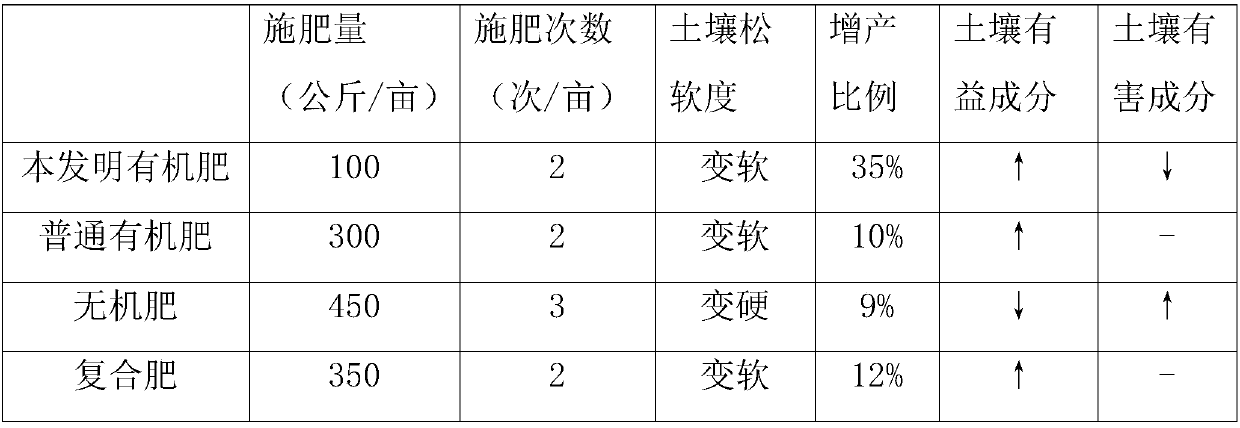Olive waste material organic fertilizer
A technology of organic fertilizer and waste, applied in the direction of organic fertilizer, fertilizer made of biological waste, nitrogen fertilizer, etc., can solve the problems of small effective use space of olive leaves, complicated extraction process, and increased environmental burden, so as to be beneficial to growth and development, Nutrient-rich, soil-improving effect
- Summary
- Abstract
- Description
- Claims
- Application Information
AI Technical Summary
Problems solved by technology
Method used
Image
Examples
Embodiment 1
[0012] A kind of olive waste organic fertilizer of the present embodiment, the raw material comprises the following components by weight: 30 parts of olive pomace, 10 parts of olive leaf, 10 parts of olive branch wood vinegar, 20 parts of bran powder, 5 parts of mushroom dregs, poly 0.1 part of acrylamide, 0.05 part of marine Bacillus, 0.01 part of Bacillus thuringiensis, 0.01 part of Phanerochaete chrysosporium, 5 parts of rapeseed cake, 10 parts of modified biochar, 1 part of polyvinyl acetate, ε-polylysine 5 parts of amino acid, 1 part of propionyl brassinolide, and 3 parts of ammonium molybdate; the effective number of viable bacteria of the marine bacillus, bacillus thuringiensis and Phanerochaete chrysosporium is respectively 50 billion / g; The modified biochar is prepared in the following way: the dried cow manure that is crushed to a particle size of 0.3 cm is dissolved in magnesium chloride hexahydrate with a magnesium ion concentration of 2.0 mol / L and immersed in a ma...
Embodiment 2
[0016] A kind of olive waste organic fertilizer of the present embodiment, the raw material comprises the following components by weight: 50 parts of olive pomace, 20 parts of olive leaves, 20 parts of olive branch wood vinegar, 30 parts of bran powder, 15 parts of mushroom dregs, 1 part of acrylamide, 0.3 part of marine Bacillus, 0.1 part of Bacillus thuringiensis, 0.1 part of Phanerochaete chrysosporium, 15 parts of rapeseed cake, 20 parts of modified biochar, 5 parts of polyvinyl acetate, ε-polylysine 10 parts of amino acid, 5 parts of propionyl brassinolide, 10 parts of ammonium molybdate; the effective number of viable bacteria of described marine bacillus, bacillus thuringiensis and Phanerochaete chrysosporium is respectively 50 billion / g; The modified biochar is prepared in the following way: the dried cow manure that is crushed to a particle size of 0.6 cm is dissolved in magnesium chloride hexahydrate with a magnesium ion concentration of 2.0 mol / L and then filtered fo...
Embodiment 3
[0020] A kind of olive waste organic fertilizer of the present embodiment, the raw material comprises the following components by weight: 30 parts of olive pomace, 20 parts of olive leaves, 10 parts of olive branch wood vinegar, 30 parts of bran powder, 5 parts of mushroom dregs, 1 part of acrylamide, 0.05 part of marine Bacillus, 0.1 part of Bacillus thuringiensis, 0.01 part of Phanerochaete chrysosporium, 15 parts of rapeseed cake, 10 parts of modified biochar, 5 parts of polyvinyl acetate, ε-polylysine 5 parts of amino acid, 5 parts of propionyl brassinolide, 3 parts of ammonium molybdate; The effective number of viable bacteria of described marine bacillus, bacillus thuringiensis and Phanerochaete chrysosporium is respectively 50 billion / g; The modified biochar is prepared in the following way: the dried cow manure that is crushed to a particle size of 0.6 cm is dissolved in magnesium chloride hexahydrate with a magnesium ion concentration of 2.0 mol / L and then filtered for...
PUM
 Login to View More
Login to View More Abstract
Description
Claims
Application Information
 Login to View More
Login to View More - R&D
- Intellectual Property
- Life Sciences
- Materials
- Tech Scout
- Unparalleled Data Quality
- Higher Quality Content
- 60% Fewer Hallucinations
Browse by: Latest US Patents, China's latest patents, Technical Efficacy Thesaurus, Application Domain, Technology Topic, Popular Technical Reports.
© 2025 PatSnap. All rights reserved.Legal|Privacy policy|Modern Slavery Act Transparency Statement|Sitemap|About US| Contact US: help@patsnap.com

